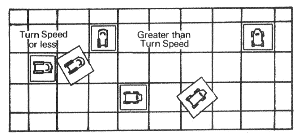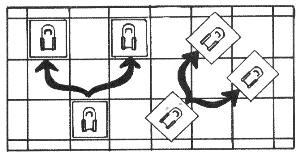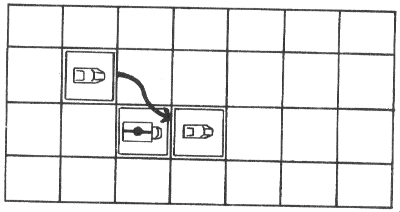
The following standard vehicles are available on STAR FRONTIERS worlds.
Ground Car
| Cost: Top/Cruise Speed: Passengers: Cargo Limit: | 5,000 Cr (rental --- 50 Cr plus 50 Cr/day) 100 kph/60 kph 6 150 kg, 1 cubic meter |
A ground car is a wheeled vehicle similar to cars in use today, except it runs on a parabattery instead of gasoline. Because ground cars run in contact with the ground, they are very maneuverable. A ground vehicle can cross almost any type of terrain if it has enough ground clearance. However, they are not as fast as hover vehicles on level ground or roads.
Ground Transport
| Cost: Top/Cruise Speed: Passengers: Cargo Limit: | 15,000 Cr (rental --- 75 Cr plus 100 Cr/day) 75 kph/60 kph 3 10,000 kg, 30 cubic meter |
Ground transports are heavy, wheeled trucks. They can have open or enclosed cargo areas.
Ground Cycle
| Cost: Top/Cruise Speed: Passengers: Cargo Limit: | 2,000 Cr (rental --- 25 Cr plus 25 Cr/day) 120 kph/60 kph 2 20 kg, .5 cubic meter |
Ground cycles are similar to today's motorcycles. They are fast and very maneuverable.
Hover Car
| Cost: Top/Cruise Speed: Passengers: Cargo Limit: | 8,000 Cr (rental --- 50 Cr plus 75 Cr/day) 150 kph/60 kph 6 100 kg, 1 cubic meter |
A hovercar or "skimmer" is a car that floats on a cushion of air 30 centimeters above the ground. A pair of turbo fans propel it through the air. In general, hover vehicles are faster than ground vehicles, but are less maneuverable and are limited to traveling on fairly level surfaces or calm water.
Hover Transport
| Cost: Top/Cruise Speed: Passengers: Cargo Limit: | 20,000 Cr (rental --- 75 Cr plus 150 Cr/day) 150 kph/90 kph 3 10,000 kg, 35 cubic meters |
A hover transport is a heavy truck version of a skimmer.
Hovercycle
| Cost: Top/Cruise Speed: Passengers: Cargo Limit: | 2,000 Cr (rental --- 25 Cr plus 25 Cr/day) 100 kph/80 kph 2 20 kg, .5 cubic meter |
Hovercycles are two-man hover vehicles similar to motorcycles. They are easier to ride and control than a ground cycle, but are not as maneuverable at high speeds.
Explorer
| Cost: Top/Cruise Speed: Passengers: Cargo Limit: | 20,000 Cr (rental --- 75 Cr plus 200 Cr/day) 90 kph/50 kph 6 2,000 kg, 6 cubic meters |
Explorers are heavy, four-wheeled vans built for traveling and exploring in rugged areas. They are very maneuverable and reliable. Each wheel has its own motor, and the extra-wide tires make it very stable. Explorers are air-tight and have a retractable rudder so they can cross open water, but they can be capsized by high waves.
Glijet
| Cost: Top/Cruise Speed: Passengers: Cargo Limit: | 3,000 Cr (rental --- 75 Cr plus 50 Cr/day) 100 kph/30 kph 1 15 kg, .1 cubic meter |
A glijet is a combination rocketpack and hang glider. The rocketpack is used to fly to high altitude, where the glider wings are extended. The user can glide slowly with the wings, or use the rocketpack to fly at higher speed. The chemical rocket pack weighs 2 kg and costs 50 Cr to refill.
Jetcopter
| Cost: Top/Cruise Speed: Passengers: Cargo Limit: | 40,000 Cr (rental --- 100 Cr plus 80 Cr/day) 350 kph/50 kph 4 500 kg, 5 cubic meters |
A jetcopter is a helicopter with jet engines. They can be flown like normal helicopters at up to 50 kph. Using the jet engines allows them to fly at speeds up to 350 kph.
Aircar
| Cost: Top/Cruise Speed: Passengers: Cargo Limit: | 50,000 Cr (rental --- 100 Cr plus 100 Cr/day) 900 kph/400 kph 4 1,000 kg, 2 cubic meters |
An aircar is a vertical take-off and landing vehicle, or VerTOL. It takes off and lands like a helicopter, but flies like an airplane.
Parabatteries
All of the vehicles described above, except the glijet, are powered by parabatteries. Parabatteries range in size from fist-sized to 1 cubic meter. The following four types are used in vehicles:
| Type 1 ( 600 Cr): Type 2 (1,200 Cr): Type 3 (2,300 Cr): Type 4 (4,500 Cr): | groundcycles and hovercycles groundcars and hovercars trucks, hovertrucks and explorers aircars and jetcopters |
Range. All vehicles listed above can travel 1,000 km on a new parabattery before it is out of energy and must be recharged. A glijet does not use a parabattery; its range varies with fuel use, altitude and air currents.
| Meters/turn | kph | mph | Meters/turn | kph | mph
| 5 | 10 20 30 40 50 60 70 80 3 | 6 12 18 24 30 36 42 48 2 | 4 8 11 15 19 23 26 30 90 | 100 125 150 175 200 250 300 350 54 | 60 75 90 105 120 150 180 210 34 | 38 47 56 66 75 94 112 131 | ||||||
Acceleration
A driver can increase the speed of his vehicle at the start of every game turn. To do this, the player decides how much faster he wants to move, and adds this number of meters/turn to his current speed. There is a limit to how much a vehicle's speed can be increased in one turn. This limit is the vehicle's acceleration rate. The Vehicle Data Table shows acceleration rates for all the ground vehicles in meters/turn.
EXAMPLE: During its last move, a skimmer traveled 40 meters/turn. Its acceleration rate is 80 meters/turn. At the beginning of its next move, the driver of the skimmer can increase its speed to 120 meters/turn (40 + 80 =120).
Deceleration
A driver can slow down his vehicle at the start of each game turn. To do this, he subtracts the amount he is decelerating from his current speed; the result is his speed for this turn. If the result is 0, the vehicle has stopped and it does not move this turn. The amount a vehicle can slow down in one turn is limited by its deceleration rate. Deceleration rates for ground vehicles are shown on the Vehicle Data Table.
Emergency Stopping. A vehicle can come to a complete stop from any speed in one turn by making an emergency stop. The vehicle moves one-half of its starting speed. At the end of the turn its speed is 0. The driver must make a Reaction Speed check to keep the vehicle under control. If he fails the check, he loses control; see Crashes, below.
Maximum Speed
No matter what its acceleration is, a vehicle can not move faster than its maximum speed. Maximum speeds are listed on the Vehicle Data Table.
Backing Up
A vehicle can drive backward at up to 50 meters/turn. A vehicle that is moving forward must come to a complete stop before moving in reverse. Avehicle's acceleration rate in reverse is one-half its normal acceleration.
Tum Speed
The Vehicle Data Table shows turn speeds for the ground vehicles. A vehicle can turn 45 degrees to the right or left in every 5-meter square it enters if its speed in meters/turn is equal to or less than its turn speed. If the vehicle is traveling faster than its turn speed, it must move straight at least 10 meters after making a 45 degree turn before it can turn again. This information is summarized on the table below. See the diagram for examples.
| Vehicle Traveling at | Distance Between Turns
| Turn Speed or less | Greater than Turn Speed 5 meters | 10 meters | ||
Straight movement from the previous turn can be counted toward these requirements.
A driver can turn a vehicle more sharply than indicated above, but risks losing control or crashing; see Short Corners.

| Vehicle | Accel. (m/turn) | Decel. (m/turn) | Top Speed (m/turn) | Turn Speed (m/turn) Ground Car | Ground Transport Ground Cycle Hover Car Hover Transport Hover Cycle Explorer 60 | 40 100 80 60 100 60 40 | 30 40 40 30 40 40 175 | 125 200 250 250 175 150 80 | 50 100 70 40 90 100 | |||||
Special Maneuvers
Besides driving straight and turning corners, vehicles, can perform special maneuvers. These include slips, pivots, skid turns, bumps and stunts.
Slipping. Slipping is similar to "changing lanes"; it allows a vehicle to swerve to the right or left without changing its direction of travel. Any type of vehicle can slip. A slipping vehicle moves 10 meters ahead and 5 meters to either side. This counts as only 10 meters of movement. A vehicle can not turn while slipping. A vehicle can slip once for every 10 meters it moves.

Pivot. A pivot is a turn of up to 360 degrees performed in one spot. Only hover vehicles and Explorers can pivot. A vehicle must be stationary at the beginning of the turn to pivot. The pivoting vehicle stays in the same square, and the driver can rotate it so it points in any direction.
Skid Turns. A skid turn is done by slamming on the brakes while turning so the vehicle skids around 180 degrees. Only ground cars ground cycles and Explorers can perform skid turns. The vehicle must be traveling from 60 to 80 meters/turn. It actually will move only 20 meters during the turn, and have a speed of O at the start of the next turn.

The driver of the vehicle rolls percentile dice. If the result is less than or equal to his Reaction Speed, the driver performs the skid turn safely. If the result is higher than the driver's Reaction Speed, the vehicle will point in a random direction when it stops skidding. When this happens, move the vehicle as if it had skidded successfully. Now roll 1d10 and turn the vehicle 45 degrees clockwise a number of times equal to the number rolled.
Bumping. A driver can try to make another vehicle crash by bumping it. In order to bump, the driver or his team must have initiative for the turn. The driver must slip directly in front of the other vehicle. Both drivers then make Reaction Speed checks. The driver who performed the slip makes a normal check, but the driver whose vehicle was bumped has a modif ier of - 15. If either driver fails the check, he loses control of his vehicle (see Crashes).

Stunts. Drivers can perform other stunts, such as jumping their vehicles over bridges, at the referee's discretion. Things to consider when setting up a stunt are the type of vehicle being used, the amount of open space the vehicle has toworkwith, and the vehicle's condition and cargo.
Short Corners
A driver can try to turn his vehicle tighter than its speed allows, but risks losing control of the vehicle and crashing.
A driver shortens a corner if he tries to turn 5 meters before he should. For example, a ground cycle has a turning speed of 100 meters/turn. If the cycle is traveling 150 meters/turn, it must travel straight 10 meters aher making a turn before it can turn again. If the driver tries to make the second 45 degree turn after traveling straight only 5 meters, he is shortening the corner by 5 meters.
Whenever a driver shortens a corner, the player must roll d100. If the result is less than or equal to the driver's Reaction Speed, the driver makes the turn safely. If the result is higher than the driver's Reaction Speed, the driver loses control during the turn (see Crashes).
| Die Roll | Result
| 02- 79 | 80- 139 140-199 200-259 260-349 350-450 Reduce Speed 20 meters/turn | Reduce Speed 50 meters/turn Skid Spin Roll Roll and Burn |
Explanation of Results
REDUCE SPEED. The vehicle immediately reduces its speed by the indicated amount. If this is more than half of the vehicle's current speed, the vehicle slows down to one-half its current speed. The vehicle finishes the move at this new speed.
SKID. The vehicle is skidding out of control. Divide its speed in meters per turn by 10, rounding fractions up. Move the vehicle this number of meters in the direction it was moving before it went out of control. If the vehicle skids into a building or other obstacle, treat it as a collision (see Collisions). Otherwise, the vehicle continues moving from its new position.
SPIN. The vehicle is skidding out of control and spinning. Divide its remaining movement by two. Move it that many meters in the direction it was traveling before it started skidding. Now roll 1d10 and turn the vehicle 45 degrees clockwise a number of times equal to the number on the die. On the next turn the vehicle will skid to a stop. Move it one-half of its speed in the direction it was traveling before it went out of control and roll 1d10 again to determine how much it spins.
ROLL. The vehicle is rolling out of control. Treat this the same as a spin, but do not roll 1d10 to determine the vehicle's facing. Instead, each passenger in the vehicle suffers 1 d10 points of damage. When the vehicle stops rolling, roll 1d10; if the result is 1, 2 or 3, the vehicle is right-side-up. Otherwise it is on its side or top. The vehicle will run again in 1d10 turns if it was traveling at its turn speed or less.
ROLL AND BURN. This is the same as a roll, but the vehicle is burning also. Each passenger suffers an additional 1d10 damage from the fire at the start of each turn he is in the vehicle. A character can get out of the vehicle in one turn if it has stopped rolling. If a character tries to get out of the vehicle while it is rolling, he must make a Reaction Speed check. If he passes the check, he has escaped from the vehicle. If he fails the check, he has not gotten away from the vehicle and he suffers an additional 1d10 damage immediately.
Collisions
If a moving vehicle hits a building, rock, other vehicle or obstacle of any type, it has had a collision. The vehicle stops moving immediately.
Damage to Vehicles. If the vehicle was traveling faster than its turn speed, it will not run again without extensive repairs. If the vehicle was traveling at its turn speed or slower, it can be driven again after 1 d10 turns. However, its acceleration and turn speed are reduced by 20 meters/turn.
Injury to Passengers. When a vehicle crashes, divide its speed in meters/turn by 20, rounding fractions down. The result is the number of d10 that are rolled to determine how many points of damage each character takes. Add 2 points to each die result if the character was riding a ground or hover cycle, and subtract 2 from each die if the character was riding in an Explorer (no die roll can be modified below 0). This information is summarized on the table below.
| Per 20 meters/turn of vehicle's speed Riding on ground cycle or hover cycle Riding in Explorer | 1d10 +2 per d10 -2 per d10 |
ARMOR. Skeinsuits and inertia screens will absorb half of the damage a character suffers in a crash.
Crashing Through Obstacles. If characters try to drive through a barricade or obstacle, the referee must use his discretion to decide how badly the vehicle is damaged, whether it keeps running, and whether the passengers are hurt. A vehicle may be able to smash through obstacles that are less solid than concrete posts or parked vehicles.